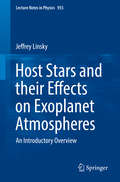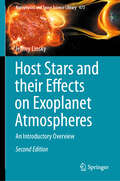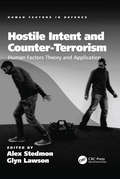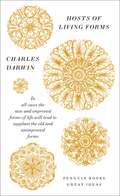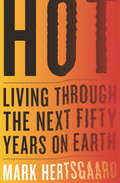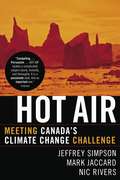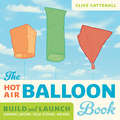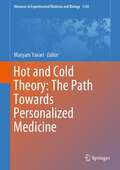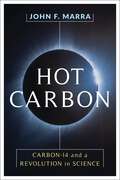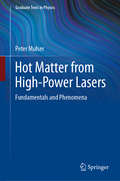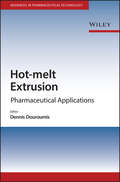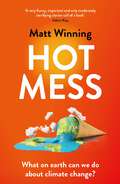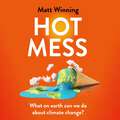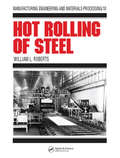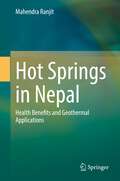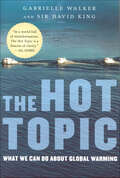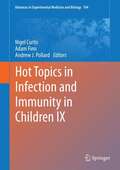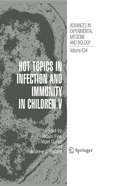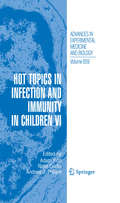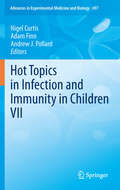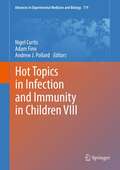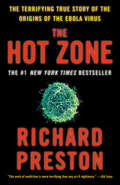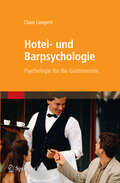- Table View
- List View
Host Stars and their Effects on Exoplanet Atmospheres: An Introductory Overview (Lecture Notes in Physics #955)
by Jeffrey LinskyLike planets in our solar system, exoplanets form, evolve, and interact with their host stars in many ways. As exoplanets acquire material and grow to the final size, their atmospheres are subjected to intense UV and X-radiation and high-energy particle bombardment from the young host star. Whether a planet can retain its atmosphere and the conditions for significant mass loss both depend upon the strength of the host star's high-energy radiation and wind, the distance of the exoplanet from its host star, the gravitational potential of the exoplanet, and the initial chemical composition of the exoplanet atmosphere. This introductory overview describes the physical processes responsible for the emission of radiation and acceleration of winds of host stars that together control the environment of an exoplanet, focusing on topics that are critically important for understanding exoplanetary atmospheres but are usually not posed from the perspective of host stars. Accordingly, both host stars and exoplanets are not studied in isolation but are treated as integrated systems. Stellar magnetic fields, which are the energy source for activity phenomena including high-energy radiation and winds, play a critical role in determining whether exoplanets are habitable. This text is primarily for researchers and graduate students who are studying exoplanet atmospheres and habitability, but who may not have a background in the physics and phenomenology of host stars that provide the environment in which exoplanets evolve. It provides a comprehensive overview of this broad topic rather than going deeply into many technical aspects but includes a large list of references to guide those interested in pursuing these questions. Nonspecialists with a scientific background should also find this text a valuable resource for understanding the critical issues of contemporary exoplanet research.
Host Stars and their Effects on Exoplanet Atmospheres: An Introductory Overview (Astrophysics and Space Science Library #473)
by Jeffrey LinskyThis comprehensive introductory overview describes the emission of radiation (X-rays to radio) and the winds of host stars and how they control the past, present, and future evolution of an exoplanet. The book focuses on topics that are critically important for understanding exoplanet atmospheres but are often posed without a comprehensive and detailed understanding of the host star and its effects on the exoplanet. Although both stars and exoplanets are usually studied in isolation, in this book they are treated as an integrated system. Whether or not an exoplanet can retain its atmosphere and the chemical composition of the atmosphere depends critically on the strength, time dependence, and spectral energy distribution of the host star's radiation, flares, coronal mass ejections, and wind, which are described in detail in the book. The book describes the roles played by magnetic fields in the coronae and chromospheres of host stars that tie together stellar active phenomena with major effects on exoplanet atmospheres. In the era of JWST and very sensitive ground- and space-based instruments, a critical topic is the noise imposed on radial velocity measurements and transit photometry and spectroscopy by the host star's activity and variability that fundamentally limit our understanding of exoplanet properties. This topic is addressed in detail in the book. This book is written primarily for graduate students and researchers who are studying exoplanet atmospheres and habitability, but who may not have a background in the physics and phenomenology of host stars. The book could serve as a reference book for graduate level classes on exoplanets. Nonspecialists with a scientific background should also find this text a valuable resource for understanding the critical issues of contemporary exoplanet research. This new edition of “Host Stars and their Effects on Exoplanet Atmospheres" is a major revision of the existing book in the following ways: It includes a new discussion of how stellar noise fundamentally limits our understanding of exoplanet atmospheres It demonstrates in detail how stellar activity acts as fundamental driver of exoplanet atmosphere evolution It provides an outlook on how the field of exoplanet atmospheres and bio-astrophysics is being driven by powerful new telescopes and instruments It extensively updates many chapters, in particular concerning host star extreme- and far-ultraviolet emission, stellar winds, stellar surface structures, the effects of space weather on exoplanets, and provides a realistic evaluation of habitability taking into account the evolution of host star activity.
Hostile Intent and Counter-Terrorism: Human Factors Theory and Application (Human Factors in Defence)
by Glyn Lawson Alex StedmonThis volume presents world-leading ideas and research that explores some of the most prominent topics relevant to detecting terrorism. The book is divided into six key themes: conceptualising terrorism, deception and decision making, social and cultural factors in terrorism, modelling hostile intent, strategies for counter-terrorism, and future directions. Twenty two chapters cover the spectrum of detecting terrorist activities, hostile intent, crowded public spaces and suspicious behaviour. The work draws from high impact research findings and presents case-studies to help communicate concepts. Specific areas of interest include methodological issues in counter-terrorism, counter terrorism policy and its impact on end users, novel research methods and innovative technologies in counter-terrorism. A variety of disciplines are represented by this work, including: ergonomics/human factors, psychology, criminology, cognitive science, sociology, political theory, art/design, engineering and computer science. This book not only expands the knowledge base of the subject area and is therefore of prime relevance to researchers investigating counter-terrorism, but provides a valuable resource to security stakeholders at policy and practitioner levels.
Hosts of Living Forms (Penguin Great Ideas Ser.)
by Charles DarwinCharles Darwin transformed our understanding of the world with the idea of natural selection, challenging the notion that species are fixed and unchanging. These writings from On the Origin of Species explain how different life forms appear all over the globe, evolve over millions of years, become extinct and are supplanted.GREAT IDEAS. Throughout history, some books have changed the world. They have transformed the way we see ourselves - and each other. They have inspired debate, dissent, war and revolution. They have enlightened, outraged, provoked and comforted. They have enriched lives - and destroyed them. Now Penguin brings you the works of the great thinkers, pioneers, radicals and visionaries whose ideas shook civilization and helped make us who we are.
Hot: Living Through the Next Fifty Years on Earth (National Climate Seminar Ser. #5)
by Mark HertsgaardA fresh take on climate change by a renowned journalist driven to protect his daughter, your kids, and the next generation who'll inherit the problem For twenty years, Mark Hertsgaard has investigated global warming for outlets including the New Yorker, NPR, Time, Vanity Fair, and The Nation. But the full truth did not hit home until he became a father and, soon thereafter, learned that climate change had already arrived-a century earlier than forecast-with impacts bound to worsen for decades to come. Hertsgaard's daughter Chiara, now five yea rs old, is part of what he has dubbed "Generation Hot"--the two billion young people worldwide who will spend the rest of their lives coping with mounting climate disruption. HOT is a father's cry against climate change, but most of the book focuses on s olutions, offering a deeply reported blueprint for how all of us-as parents, communities, companies and countries-can navigate this unavoidable new era. Combining reporting from across the nation and around the world with personal reflections on his daugh ter's future, Hertsgaard provides "pictures" of what is expected over the next fifty years: Chicago's climate transformed to resemble Houston's; dwindling water supplies and crop yields at home and abroad; the redesign of New York and other cities against mega-storms and sea-level rise. Above all, he shows who is taking wise, creative precautions. For in the end, HOT is a book about how we'll survive.
Hot Air: Meeting Canada's Climate Change Challenge
by Jeffrey Simpson Nic Rivers Mark JaccardHere's a clear, believable book for Canadians concerned about our situation -- and it offers a solution. It's a brilliant mix. To "Canada's best mind on the environment," Mark Jaccard, who won the 2006 Donner Prize for an academic book in this area, you add Nic Rivers, a researcher who works with him at Simon Fraser University. Then you add Jeffrey Simpson, the highly respected Globe and Mail columnist, to punch the message home in a clear, hard-hitting way. The result is a unique book.Most other books on energy and climate change are: (a) terrifying or (b) academic or (c) quirky, advocating a single, neat solution like solar or wind power. This book is different. It starts with an alarming description of the climate threat to our country. Then it shifts to an alarming description of how Canadians have been betrayed by their politicians ("We're working on it!"), their industrialists ("Things aren't that bad, really, and voluntary guidelines will be good enough."), and even their environmentalists ("Energy efficiency can be profitable, and people can change their lifestyles!") All of this, of course, reinforces the myths that forceful policies are not needed. Hot Air then lays out in convincing and easily understandable terms the few simple policies that Canada must adopt right away in order to significantly reduce greenhouse gas emissions over the next few decades. It even shows how these policies can be designed to have minimal negative effects. With evidence from other countries that are successfully addressing climate change, Hot Air shows why these are the only policies that will work -- and why this is a matter of life and death for all of us.
The Hot Air Balloon Book: Build and Launch Kongming Lanterns, Solar Tetroons, and More (Science in Motion)
by Clive CatterallWith detailed, step-by-step instructions, this richly illustrated science project book shows how to construct and safely launch homemade balloons. Some designs, including the Solar Tetroon or the Giant Solar Sausage, are made from garbage bags and tape, while others, such as the Khom Loi, are created from tissue paper and wire; yet all of the projects use inexpensive, readily available materials and are easy to construct with only basic crafting skills. Ever safety conscious, this manual provides detailed guidelines for various methods to heat the interior air that lifts the balloons, including when and where open flames are appropriate, and the proper weather conditions to launch these creations. With a full chapter on troubleshooting, should a design fail to fly, this book will make balloon engineers of just about anyone.
Hot and Cold Theory: The Path Towards Personalized Medicine (Advances in Experimental Medicine and Biology #1343)
by Maryam YavariThis book is about the theory of Hot and Cold, a mutual fundamental base of traditional medicines all around the world. The theory describes the dynamic balance state of the body on the axis of hot and cold for each individual and proposes the fact that deviation from this equilibrium is a predisposing factor for diseases. Such an approach helps practitioners to provide treatments tailored to the patient’s condition, not the disease. This book, for the first time, has gathered native descriptions of Hot and Cold theory in different traditional medicines, including traditional Chinese medicine, Persian (Humoral, Unani) medicine, Ayurvedic medicine and Latin American and Caribbean medicines. After defining the common ground, contemporary research - in nutrition, pharmacology, physiology and systems biology - has been explored using scientific methodology. This work is the result of an international collaboration of more than 30 scientists and scholars with high reputations in their fields. Hot and Cold theory, as a holistic individualized approach in prevention, diagnosis and treatment, can be merged into the novel fast-paced concepts in systems biology and precision medicine. Through this bridge, the authors propose that the Hot and Cold theory should be revisited more deeply by medical scientists, who are the main audience of this book, to pave the way towards integrated holistic personalized medicine.
Hot Carbon: Carbon-14 and a Revolution in Science
by Professor John F. MarraThere are few fields of science that carbon-14 has not touched. A radioactive isotope of carbon, it stands out for its unusually long half-life. Best known for its application to estimating the age of artifacts—carbon dating—carbon-14 helped reveal new chronologies of human civilization and geological time. Everything containing carbon, the basis of all life, could be placed in time according to the clock of radioactive decay, with research applications ranging from archeology to oceanography to climatology.In Hot Carbon, John F. Marra tells the untold story of this scientific revolution. He weaves together the workings of the many disciplines that employ carbon-14 with gripping tales of the individuals who pioneered its possibilities. He describes the concrete applications of carbon-14 to the study of all the stuff of life on earth, from climate science’s understanding of change over time to his own work on oceanic photosynthesis with microscopic phytoplankton. Marra’s engaging narrative encompasses nuclear testing, the peopling of the Americas, elephant poaching, and the flax plants used for the linen in the Shroud of Turin. Combining colorful narrative prose with accessible explanations of fundamental science, Hot Carbon is a thought-provoking exploration of how the power of carbon-14 informs our relationship to the past.
Hot Matter from High-Power Lasers: Fundamentals and Phenomena (Graduate Texts in Physics)
by Peter MulserThis book offers an introduction to the booming field of high-power laser-matter interaction. It covers the heating of matter to super-high temperatures and pressures, novel schemes of fast particle acceleration, matter far from thermal equilibrium, stimulated radiation scattering, relativistic optics, strong field QED, as well as relevant applications, such as extreme states of matter, controlled fusion, and novel radiation sources. All models and methods considered are introduced as they arise and illustrated by relevant examples. Each chapter contains a selection of problems to test the reader's understanding, to apply the models under discussion to relevant situations and to discover their limits of validity. The carefully chosen illustrations greatly facilitate the visualization of physical processes as well as presenting detailed numerical results. A list of useful formulas and tables are provided as a guide to quantifying results from experiments and numerical simulations. Each chapter ends with a description of the state of the art and the current research frontiers.
Hot-Melt Extrusion
by Dennis DouroumisHot-melt extrusion (HME) - melting a substance and forcing it through an orifice under controlled conditions to form a new material - is an emerging processing technology in the pharmaceutical industry for the preparation of various dosage forms and drug delivery systems, for example granules and sustained release tablets.Hot-Melt Extrusion: Pharmaceutical Applications covers the main instrumentation, operation principles and theoretical background of HME. It then focuses on HME drug delivery systems, dosage forms and clinical studies (including pharmacokinetics and bioavailability) of HME products. Finally, the book includes some recent and novel HME applications, scale -up considerations and regulatory issues. Topics covered include:principles and die design of single screw extrusiontwin screw extrusion techniques and practices in the laboratory and on production scaleHME developments for the pharmaceutical industrysolubility parameters for prediction of drug/polymer miscibility in HME formulationsthe influence of plasticizers in HMEapplications of polymethacrylate polymers in HMEHME of ethylcellulose, hypromellose, and polyethylene oxidebioadhesion properties of polymeric films produced by HMEtaste masking using HMEclinical studies, bioavailability and pharmacokinetics of HME productsinjection moulding and HME processing for pharmaceutical materialslaminar dispersive & distributive mixing with dissolution and applications to HMEtechnological considerations related to scale-up of HME processesdevices and implant systems by HMEan FDA perspective on HME product and process understandingimproved process understanding and control of an HME process with near-infrared spectroscopyHot-Melt Extrusion: Pharmaceutical Applications is an essential multidisciplinary guide to the emerging pharmaceutical uses of this processing technology for researchers in academia and industry working in drug formulation and delivery, pharmaceutical engineering and processing, and polymers and materials science.This is the first book from our brand new series Advances in Pharmaceutical Technology. Find out more about the series here.
Hot Mess: What on earth can we do about climate change?
by Matt Winning'A very funny, important and only moderately terrifying clarion call of a book' - Adam Kay'HOT MESS provides loads of laughs about "the climate situation" and will position you at the right point between fear and determination' - Mark Watson 'Hilarious, informative and worrying in equal measure. And that's just the bits about having a baby' - Josie LongFor fans of Randall Munro's WHAT IF? Matt Parker's HUMBLE PI and anyone looking for practical tips on how to stop the end of the world!Dr Matt Winning is a stand-up comedian and environmental economist with a PHD in climate change policy, which means he's the sort of doctor who will rush to your side if you fall ill on a plane, but only to berate you for flying. We are currently facing a global climate emergency. You've probably noticed. But why does the end of the world need to be so depressing? HOT MESS aims to both lighten the mood and enlighten readers on climate change. This is a book for people who care about climate change but aren't doing much about it, helping readers understand what the main causes of climate change are, what changes are needed, and what they can (and cannot) do about it. But, most importantly, it is book that'll help people find the comedy in climate change, because if we can do that, well, we can do bloody anything.'Climate change is no laughing matter - oh yes it is - with Matt Winning's superb, hilarious, side-splitting book that makes you take a whole new look at the climate crisis, surviving having children and life in general' - Mark Maslin, author of How to Save Our Planet'The first book about climate change that made me laugh out loud. If you've been too freaked out to subject yourself to the climate crisis, Hot Mess is the kick in the pants you need to start making yourself useful.' - Prof. Kimberly Nicholas, author of Under the Sky We Make: How to Be Human in a Warming World
Hot Mess: What on earth can we do about climate change?
by Matt Winning'A very funny, important and only moderately terrifying clarion call of a book' - Adam Kay'HOT MESS provides loads of laughs about "the climate situation" and will position you at the right point between fear and determination' - Mark Watson 'Hilarious, informative and worrying in equal measure. And that's just the bits about having a baby' - Josie LongFor fans of Randall Munro's WHAT IF? Matt Parker's HUMBLE PI and anyone looking for practical tips on how to stop the end of the world!Dr Matt Winning is a stand-up comedian and environmental economist with a PHD in climate change policy, which means he's the sort of doctor who will rush to your side if you fall ill on a plane, but only to berate you for flying. We are currently facing a global climate emergency. You've probably noticed. But why does the end of the world need to be so depressing? HOT MESS aims to both lighten the mood and enlighten readers on climate change. This is a book for people who care about climate change but aren't doing much about it, helping readers understand what the main causes of climate change are, what changes are needed, and what they can (and cannot) do about it. But, most importantly, it is book that'll help people find the comedy in climate change, because if we can do that, well, we can do bloody anything.'Climate change is no laughing matter - oh yes it is - with Matt Winning's superb, hilarious, side-splitting book that makes you take a whole new look at the climate crisis, surviving having children and life in general' - Mark Maslin, author of How to Save Our Planet'The first book about climate change that made me laugh out loud. If you've been too freaked out to subject yourself to the climate crisis, Hot Mess is the kick in the pants you need to start making yourself useful.' - Prof. Kimberly Nicholas, author of Under the Sky We Make: How to Be Human in a Warming World
Hot Mess: What on earth can we do about climate change?
by Matt WinningWhat is climate change, who's to blame, and what the f**k can we do about it? Award-winning comedian and climate change researcher Dr Matt Winning explains all.For fans of Randall Munro's WHAT IF? Matt Parker's HUMBLE PI and anyone looking for practical tips on how to stop the end of the world!Dr Matt Winning is a stand-up comedian and environmental economist with a PHD in climate change policy, which means he's the sort of doctor who will rush to your side if you fall ill on a plane, but only to berate you for flying. We are currently facing a global climate emergency. You've probably noticed. But why does the end of the world need to be so depressing? HOT MESS aims to both lighten the mood and enlighten readers on climate change. This is a book for people who care about climate change but aren't doing much about it, helping readers understand what the main causes of climate change are, what changes are needed, and what they can (and cannot) do about it. But, most importantly, it is book that'll help people find the comedy in climate change, because if we can do that, well, we can do bloody anything.(P) 2021 Headline Publishing Group Ltd
Hot Rolling of Steel (ISSN #Vol. 10)
by William L. RobertsNumber ten of the Manufacturing Engineering and Material Processing series. Includes one page corrigenda laid-in. 800 illustrations clarifying key points. Thorough account of the hot-rolling process and facilities as well as follow-up treatments given to hot-rolled products. Companion volume to Cold Rolling of Steel by William Roberts circa 1978
Hot Springs in Nepal: Health Benefits and Geothermal Applications
by Mahendra RanjitThis book presents a profile of the majority of hot springs in and around tourist destinations in Nepal. In particular, there is a focus on Pokhara, Jumla, the world- famous Annapurna region, Ruby Valley, and Api Nampa Conservation Area. The chapter on health benefits of mineral hot springs provides a history of hot springs supported by a literature review and case study. Further chapters explore the direct uses of geothermal energy for various purposes and power generation, together with a section on conventional hydrothermal resources. This book is of interest to the general public, students, national and international researchers, energy planners, and health professionals. The book is a valuable tool for sociologists who want to gain insight into the cultural and religious aspects of hot water mineral springs.
The Hot Topic: What We Can Do about Global Warming
by Gabrielle Walker David KingOne of the most dynamic writers and one of the most respected scientists in the field of climate change offer the first concise guide to both the problems and the solutions of global warming. Guiding us past a blizzard of information and misinformation, Gabrielle Walker and Sir David King explain the science of warming, the most cutting-edge technological solutions from small to large, and the national and international politics that will affect our efforts. While there have been many other books about the problem of global warming, none has addressed what we can and should do about it so clearly and persuasively, with no spin, no agenda, and no exaggeration. Neither Walker nor King is an activist or politician, and theirs is not a generic green call to arms. Instead they propose specific ideas to fix a very specific problem. Most important, they offer hope: This is a serious issue, perhaps the most serious that humanity has ever faced. But we can still do something about it. And they’ll show us how.
Hot Topics in Infection and Immunity in Children IX (Advances in Experimental Medicine and Biology #764)
by Nigel Curtis Andrew J. Pollard Adam FinnCourse covers topics in infectious diseases in children and is intended for Pediatric Infectious disease trainees, trainers, and all those who manage children with infections. This conference is being supported by several societies and is sponsored by several pharmaceutical companies, such as Aventis, Baxter, Chiron Vaccines, Wyeth, etc.
Hot Topics in Infection and Immunity in Children V
by Nigel Curtis Andrew J. Pollard Adam FinnCourse covers topics in infectious diseases in children and is intended for Pediatric Infectious disease trainees, trainers, and all those who manage children with infections. This conference is being supported by several societies and is sponsored by several pharmaceutical companies, such as Aventis, Baxter, Chiron Vaccines, Wyeth, etc.
Hot Topics in Infection and Immunity in Children VI
by Adam Finn Andrew J. Pollard Nigel CurtisCourse covers topics in infectious diseases in children and is intended for Pediatric Infectious disease trainees, trainers, and all those who manage children with infections. This conference is being supported by several societies and is sponsored by several pharmaceutical companies, such as Aventis, Baxter, Chiron Vaccines, Wyeth, etc.
Hot Topics in Infection and Immunity in Children VII
by Nigel Curtis Andrew J. Pollard Adam FinnCourse covers topics in infectious diseases in children and is intended for Pediatric Infectious disease trainees, trainers, and all those who manage children with infections. This conference is being supported by several societies and is sponsored by several pharmaceutical companies, such as Aventis, Baxter, Chiron Vaccines, Wyeth, etc.
Hot Topics in Infection and Immunity in Children VIII
by Nigel Curtis Adam Finn Andrew J. PollardBook covers course with topics in infectious diseases in children and is intended for Pediatric Infectious disease clinical researchers, trainees, trainers, and all those who manage the research of children with infections and the children themselves. The conference is being supported by several societies and is sponsored by several pharmaceutical companies, such as Aventis, Baxter, Chiron Vaccines, Wyeth, etc. ToC reflects the scientific program found here: http://www.oxfordiic.org/#course
The Hot Zone: The Terrifying True Story of the Origins of the Ebola Virus (Large Print Bks.)
by Richard PrestonThe bestselling landmark account of the first emergence of the Ebola virus. Now a mini-series drama starring Julianna Margulies, Topher Grace, Liam Cunningham, James D'Arcy, and Noah Emmerich on National Geographic.A highly infectious, deadly virus from the central African rain forest suddenly appears in the suburbs of Washington, D.C. There is no cure. In a few days 90 percent of its victims are dead. A secret military SWAT team of soldiers and scientists is mobilized to stop the outbreak of this exotic "hot" virus. The Hot Zone tells this dramatic story, giving a hair-raising account of the appearance of rare and lethal viruses and their "crashes" into the human race. Shocking, frightening, and impossible to ignore, The Hot Zone proves that truth really is scarier than fiction.
Hotel- und Barpsychologie
by Claus LampertHotel- und Barpsychologie, was ist denn das? Der Diplom Psychologe und Psychologische Psychotherapeut Claus Lampert stellte als Pionier auf dem Gebiet der Hotel- und Barpsychologie fest, dass sich im Gastronomie Bereich viele Mitarbeiter für psychologische Zusammenhänge interessieren. So vermittelt dieses abbildungsreiche Lehrbuch branchenrelevante fundierte psychologische Grundkenntnisse und bietet zahlreiche praktische und alltagsrelevante Übungen, die dazu anregen, die Sichtweise auf das Arbeitsfeld und sich selbst zu hinterfragen. Dieses Werk ist ein kompaktes Lehrbuch für Auszubildende, sowie ein Begleitbuch für die Fort- und Weiterbildung, wie auch eine faszinierende und spannende Lektüre für alle diejenigen, die ihre Kompetenzen und ihr Wissen in diesem Bereich erweitern wollen.
